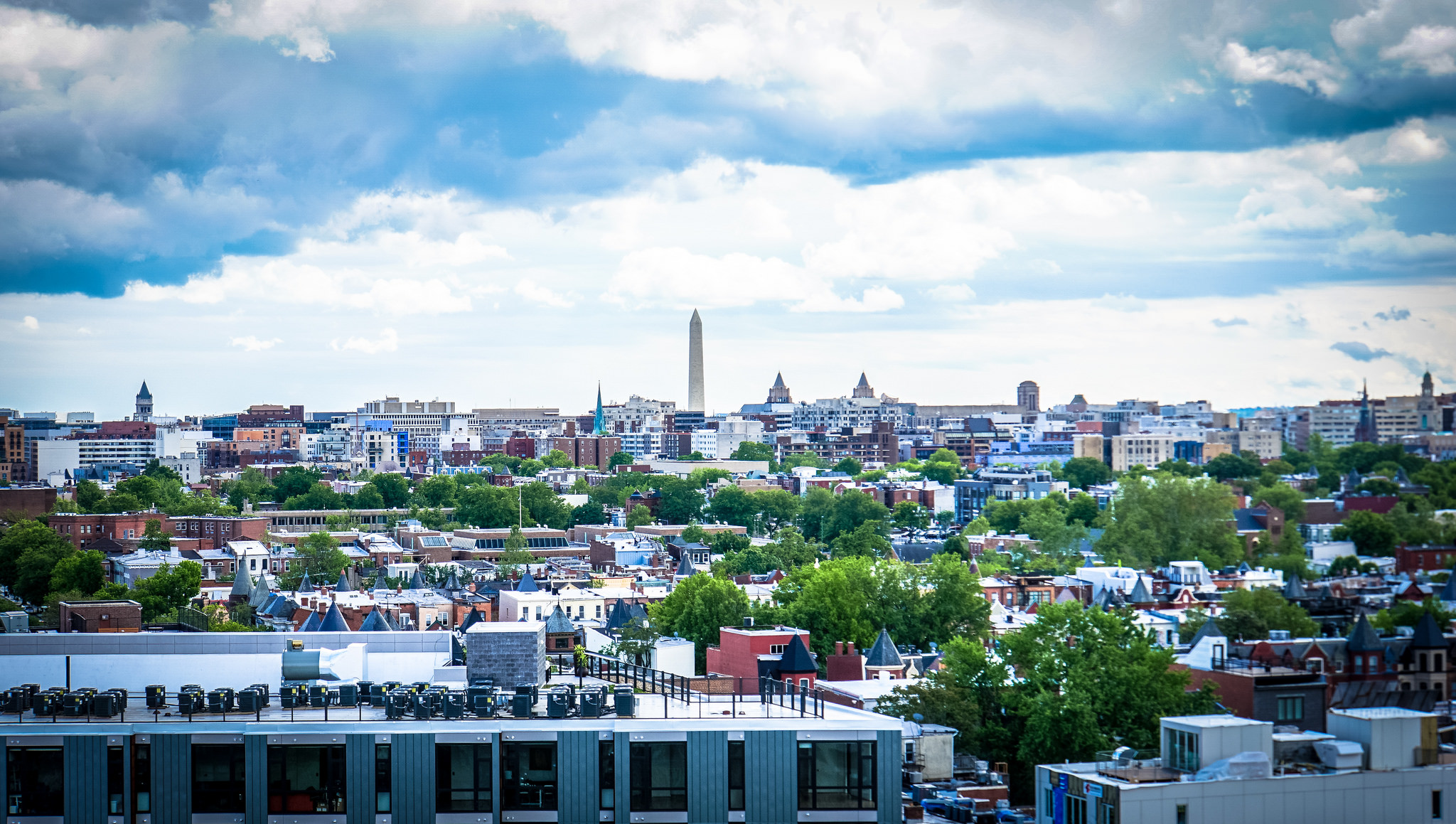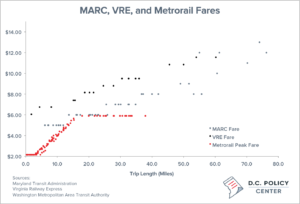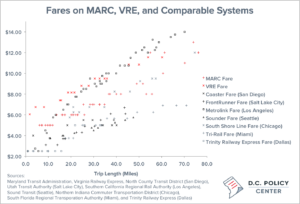Although Metrorail has been losing ridership in recent years due to poor service and SafeTrack-related disruptions, it still has the second-highest ridership in the country among rapid transit systems. In fact, population growth trends suggest that ridership is likely to grow on the western branch of the red line and in Northern Virginia, which would contribute to crowding on the most heavily-used parts of the system. At the same time, ridership is relatively low on the commuter rail systems that serve some of these same heavily-used areas. This raises the question: Why aren’t more riders using local segments of commuter rails during peak times?
I previously showed that Metrorail fares are high compared with fares on other American rapid transit systems. However, this new analysis shows that D.C.-area commuter rail fares are also high compared to similar systems, as well as being much higher than Metrorail fares for trips served by both. This means that targeted reductions of commuter rail fares for stations within Metrorail’s service area could help increase commuter rail ridership while taking some of the load off Metrorail.
Metrorail, MARC, and VRE: How rail transit in the D.C. metro area fits together
It is often noted that, in comparison to older subway systems, D.C.’s Metrorail is sort of a cross between a traditional subway and commuter rail, as it stretches far out into the suburbs and even charges distance-based fares that are higher during rush hour. However, the Washington area also has two actual commuter rail networks: MARC, which serves Maryland with three lines from Union Station (two to Baltimore and one to Frederick and West Virginia), and Virginia Railway Express (VRE), which serves Virginia with two lines from Union Station (one to Manassas and one to Fredericksburg).
While Metrorail is the second largest rapid transit system in the United States (after the New York City Subway) by both ridership and system length, MARC and VRE—which together have a total weekday ridership roughly five percent of Metrorail’s—are of an intermediate size compared to other American commuter rail systems. Like many of America’s smaller commuter rail services, they primarily provide rush-hour weekday service towards downtown in the morning and away from it in the evening. VRE and two of MARC’s three lines provide no service on weekends or evenings, and limited or no midday service. However, the MARC Penn Line, which shares its route with Amtrak’s Northeast Corridor, does run midday and evening service, as well as a limited weekend schedule.
MARC and VRE fares are higher than Metro for similar distances
As the following chart shows, MARC fares are largely comparable to rush-hour Metrorail fares for trips over 15 miles. However, MARC’s minimum fare of five dollars means that trips from its innermost stations, many of which are also Metrorail stations, are significantly more expensive on MARC than on Metrorail.
Meanwhile, VRE fares are generally about two dollars higher than MARC fares for trips of the same length. And although VRE serves trips even shorter than MARC does (such as from Union Station to L’Enfant Plaza and Crystal City), the fares for those trips are higher than even the most expensive Metrorail fare.
VRE and MARC commuter rail fares are more expensive than those on most comparable systems
We can also compare D.C.-area commuter rail fares to other commuter rail fares in the U.S. This is tricky because there is a very large amount of variation in American commuter rail networks, but a reasonable place to start is to compare MARC and VRE to systems with similar ridership and track mileage.
The above graph compares MARC and VRE to seven similarly-sized commuter rail networks in different parts of the U.S. Since some commuter rail systems charge higher fares at rush-hour (when the vast majority of their passengers ride), while others do not, or only provide rush-hour service, I have chosen to show rush-hour fares on those systems that have them.
This graph shows that VRE’s fares are among the highest for comparable commuter rail systems, and several dollars higher than the fares on any other comparable system (other than Los Angeles’ Metrolink). MARC’s fares are also relatively high, especially when compared with those in San Diego, Salt Lake City, Seattle, Miami, and Dallas-Fort Worth. These differences are particularly dramatic when looking at trips of less than ten miles, as all seven of the systems shown charge significantly lower fares for short trips than MARC and VRE do.
Takeaway: Lower fares at certain stations could increase commuter rail use and reduce Metro overcrowding
These comparisons show us that Metrorail is not the only D.C.-area rail transit network with unusually high fares by American standards. VRE is one of the country’s most expensive commuter rail networks, while MARC’s fares are above average for comparable systems.
In particular, both MARC and VRE fares are significantly higher than Metrorail fares for trips served by Metrorail. Therefore, lowering fares might be a reasonable way to increase ridership on MARC and VRE, while also reducing overcrowding on some Metrorail lines:
- Five MARC stations (New Carrollton, Greenbelt, College Park, Silver Spring, and Rockville) are also Metrorail stations, and three others (Garret Park, Kensington, and Riverdale) are closer to downtown than Metrorail stations. Lowering fares from these stations to downtown to match Metrorail fares (as is common even with other expensive commuter rail networks, such as the MBTA Commuter Railroad in Boston) could take some of the heavy rush hour passenger load off Metro, in particular the relatively crowded Red Line.
- Likewise, VRE provides service from three Virginia Metrorail stations (Crystal City, King Street-Old Town, and Franconia-Springfield) to Union Station and L’Enfant Plaza. Reducing the fares from these stations to downtown to Metrorail levels would take some of the load off the Blue and Yellow lines in Virginia. This would be particularly useful for riders from Franconia-Springfield, since the need to make room for Silver and Orange line trains in the Blue-Silver-Orange shared segment through downtown has led to significant service reductions to Franconia-Springfield and Van Dorn Street.
Unfortunately, the commuter rail lines that could best supplement overcrowded parts of the Metrorail system—VRE and the MARC Brunswick Line—are limited to rush-hour service towards downtown in the morning and away from it in the evening. This limited service is a significant barrier to increasing commuter rail ridership simply by lowering fares.
However, since MARC’s Penn and Camden lines do have some mid-day service, and since the Penn Line has weekend and evening service, one relatively cheap option for increasing ridership might be for MARC to consider lower “off-peak” fares on these trains.
Read more: Can A $2 Flat Fare Save Metro?


